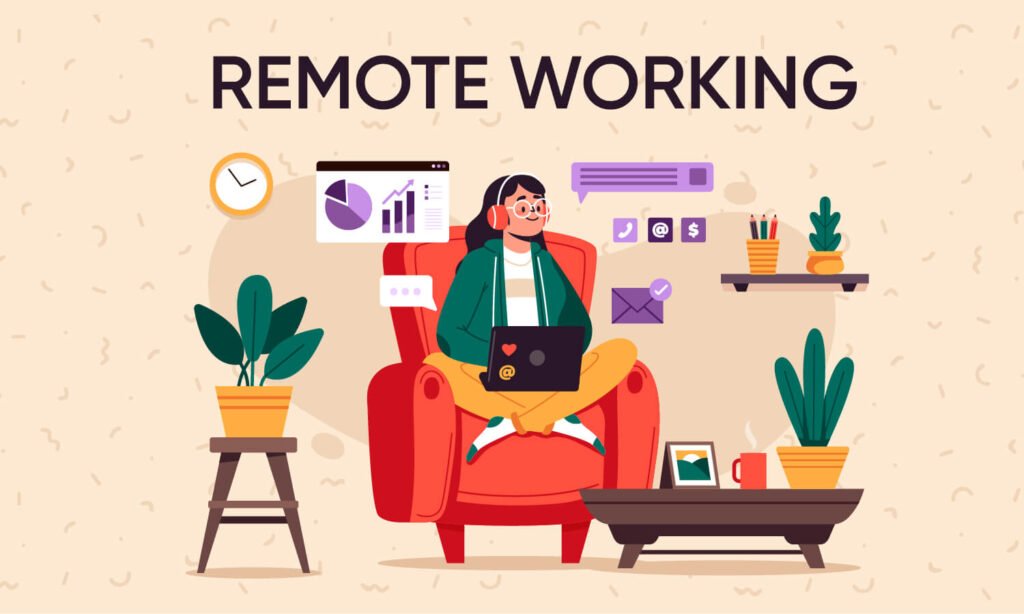Remote work has revolutionized the way we approach our professional lives. What once seemed like a luxury is now a norm for millions of people around the world. But let’s face it—working from home comes with its own set of challenges. From noisy distractions to the ever-tempting allure of that cozy sofa, staying productive can often feel like an uphill battle.
In today’s fast-moving world, where flexibility reigns supreme, remote work productivity is more than just a personal win—it’s a game-changer for businesses and individuals alike. Mastering the art of staying focused and efficient at home can help you seize opportunities, maintain work-life balance, and thrive in this new way of working.
That’s why we’re diving into 5 remote work tips that will not only help you get more done but also make your work-from-home experience feel a little smoother and more rewarding. 💼 Whether you’re a seasoned remote worker or new to the scene, these tips are your roadmap to mastering the home office hustle.
Let’s get started! 🚀
1 Optimize Your Home Workspace for Maximum Focus
Creating a dedicated workspace is one of the most effective remote work tips for boosting your productivity at home. When you work in a space specifically designed for focus, it establishes a mental boundary between “work mode” and “home mode.” This separation helps reduce distractions, improves concentration, and puts you in the right mindset to accomplish tasks efficiently.
Start by choosing a quiet area in your home where you can work without interruptions. Ideally, this should be away from high-traffic spaces or household distractions like TVs and social areas. If you don’t have a spare room, designate a corner with minimal noise and movement. A desk and ergonomic chair are must-haves—your workspace should be comfortable enough to encourage good posture and prevent physical strain during long work hours.
Lighting is another critical component. Natural light is ideal for reducing eye strain and keeping your energy levels high, so position your desk near a window if possible. Additionally, keep your space organized and clutter-free to maintain focus, and incorporate essentials like noise-canceling headphones, houseplants (to boost mood), and tools that enhance your workflow.
By intentionally designing a workspace tailored to your needs, you’ll set the stage for productivity and enjoy a seamless transition to remote work success. 🌱💻
By intentionally designing a workspace tailored to your needs, you’ll set the stage for productivity and enjoy a seamless transition to remote work success. 🌱💻
2 Set Clear Boundaries Between Work and Personal Life
One of the most crucial remote work tips for thriving at home is learning to establish clear boundaries between your work and personal life. Without this separation, it’s easy for work to spill into personal time—and vice versa—which can lead to burnout, stress, or reduced productivity.
Start by defining specific working hours, just as you would in a traditional office. Communicate these hours to your family or roommates so they understand when you’re unavailable for interruptions, helping you maintain focus. Once your workday ends, take deliberate steps to “clock out,” such as shutting down your work computer or leaving your designated workspace.
Having a physical boundary is equally important. If possible, create a separate area for work that allows you to mentally transition into “work mode.” Avoid working from your bed or couch, as these spaces are tied to relaxation. If you must use shared spaces, consider visual cues like setting up a small desk and packing it away after work to signify the end of the day.
Finally, prioritize self-discipline by resisting the urge to check emails or respond to work messages outside your established hours. By drawing a firm line between work and personal life, you’ll cultivate a healthier balance—allowing you to stay productive while fully enjoying your downtime. ✨
3 Develop a Consistent Work Routine
Establishing a consistent work routine is one of the most impactful remote work tips for improving focus and maximizing productivity. When working from home, the absence of a set structure can quickly lead to procrastination and distractions. However, sticking to a regular routine helps you create boundaries, improve time management, and build momentum throughout your day.
Begin your day with a predictable morning ritual to signal your brain that it’s time to work. Whether it’s getting dressed in work-appropriate attire, making your coffee, or reviewing your to-do list, these small actions help you transition into “work mode.” Be sure to define concrete start and end times for your workday, mirroring a traditional office schedule. This not only enhances productivity but also protects your personal time.
Incorporate breaks into your routine to recharge. Follow techniques like the Pomodoro method—short focus intervals with breaks in between—to maintain energy levels. Use a calendar tool or productivity app to schedule tasks and block out dedicated focus periods.
Lastly, adopt an evening wind-down routine to separate work from leisure, such as tidying up your workspace or reflecting on daily achievements.
By crafting and committing to a consistent routine, you’ll enjoy greater control, efficiency, and satisfaction in your remote workday. 🚀
4 Master Time Management Tools and Techniques
Mastering time management is essential for optimizing productivity while working remotely. While having a dedicated workspace creates an environment for focus, pairing it with the right tools and techniques can elevate your efficiency even further. This combination is one of the most effective remote work tips for staying on track.
Start by incorporating time-management techniques such as the Pomodoro method, which alternates focused work intervals with short breaks, to maintain energy levels throughout the day. Another useful method is time blocking—assign specific tasks to designated time slots in your schedule to ensure you tackle your priorities.
Leverage productivity tools like Trello or Asana to organize tasks into actionable lists, and use Google Calendar to plan deadlines and meetings. For tracking your work hours, apps like Time Doctor can provide insights into how you’re spending your time, helping you identify and eliminate inefficiencies.
Your dedicated workspace also plays a role in managing time effectively. Keep clocks or timers nearby to remain mindful of your schedule, and ensure your space is equipped with only the essentials to reduce distractions.
By blending these proven time management techniques with a well-organized workspace, you can create a remote work environment where focus and productivity thrive consistently. 🕒✅
5 Improve Your Communication Skills for Remote Work Success
Effective communication is essential for excelling in remote work environments. While having a dedicated workspace enhances focus and productivity, it also creates an environment that supports clear, uninterrupted communication—a vital element of remote collaboration. Mastering this balance is one of the top remote work tips to ensure professional success.
A clutter-free, well-organized workspace signals to coworkers during virtual meetings that you are professional and prepared. Position your desk in a quiet, well-lit area with minimal distractions to help you stay focused during calls or video conferences. Incorporate noise-canceling headphones and ensure your camera setup provides a clear and professional background for all virtual interactions.
To improve communication, prioritize clarity and efficiency. Use tools like email, chat software, and video conferencing platforms effectively, sticking to concise and structured messaging. Additionally, establish boundaries within your workspace where work-related discussions take precedence, helping you stay in tune with your coworkers without personal interruptions.
Finally, maintain regular touchpoints with your team. Schedule consistent check-ins and foster transparency about your availability while also respecting others’ time zones. By coupling a thoughtful approach to workspace design with communication best practices, you’ll build trust, enhance collaboration, and set yourself apart as a remote work professional. 🌐💬
Improve your setup—and your communication skills will naturally follow!
6 Take Scheduled Breaks to Recharge Your Mind
Taking regular breaks is one of the most effective remote work tips for maintaining sustained focus and high productivity throughout the day. It may sound counterintuitive, but stepping away from your tasks periodically can actually help you accomplish more. A dedicated workspace further enhances your ability to manage breaks effectively, as it creates a clear boundary between work and rest.
Design your workspace as a zone for focus, free from distractions like personal chores or TV. Use it for work-related tasks during your scheduled hours and make a habit of physically leaving this space during breaks. Stepping away, even for just 10-15 minutes, gives your mind the opportunity to reset, refresh, and return re-energized.
To optimize the impact of your breaks, plan them intentionally. Set alarms or use the Pomodoro method to build dedicated intervals of work and rest into your schedule. During your break, stretch, step outside for fresh air, or enjoy a healthy snack in another room. Avoid lingering in your workspace, as this disrupts the mental separation needed to recharge.
By coupling the habit of scheduled breaks with a well-organized, distraction-free workspace, you can foster better focus while avoiding burnout—allowing you to bring your best self to every task you tackle remotely. 🌟⏳
7 Eliminate Distractions Effectively
In the world of remote work, eliminating distractions is vital for maintaining focus and productivity. One of the most impactful remote work tips is to create a dedicated workspace that supports concentration and minimizes interruptions. A well-thought-out workspace serves as more than just a physical space; it’s a psychological cue that signals to your brain it’s time to work.
Start by selecting a quiet and comfortable area in your home. A designated workspace—even if it’s just a corner of a room—makes it easier to separate work from personal life. Equip your space with essentials like a comfortable chair, sufficient lighting, and an organized desk. Remove non-work-related items that may tempt distractions, such as gadgets, clutter, or TV remotes.
Consider tools to block digital distractions—especially if your work involves being online. Browser extensions like StayFocusd or apps like Freedom allow you to restrict access to time-wasting websites during work hours. Utilize noise-canceling headphones to block external noise, creating a focused environment.
Communicate with others in your household to set boundaries around your work hours. A simple sign or closed door can signal when you’re not to be disturbed.
By intentionally designing a workspace and addressing common distractions, you’ll foster the focus and discipline needed to succeed in remote work. 🚀📚
8 Focus on Self-Care to Boost Productivity
Self-care is a cornerstone of sustained productivity when working remotely. One of the simplest yet most powerful remote work tips is to establish a dedicated workspace that supports both your focus and well-being—essential components of self-care.
A thoughtfully created workspace provides structure, helping your mind transition into “work mode” when you’re in it, and allowing you to unplug more effectively once you step away. This separation is crucial for preventing burnout and maintaining a healthy work-life balance.
Start by setting up a workspace in a quiet area, away from household distractions. Choose ergonomic furniture, like a supportive chair and an adjustable desk, to promote physical comfort. Incorporate elements such as natural light, plants, or calming décor to create a space that energizes and inspires you. Clutter-free surroundings can also reduce mental fatigue, so aim to keep your workspace organized.
In alignment with self-care, don’t forget to schedule time for physical and mental breaks. Take a 10-minute pause to stretch, hydrate, or practice mindfulness. Having a dedicated workspace makes it easier to step away without the temptation to blur the boundaries between work and rest.
By pairing self-care practices with an optimized workspace, you enhance your ability to recharge and remain productive—striking a harmonious balance in your remote work routine. 🌱💻✨

9 Tailor Your Workflow and Tools to Suit You
One of the most valuable remote work tips is to personalize your workflow and tools to fit your style, starting with your workspace. A dedicated workspace plays a crucial role in optimizing focus and productivity when working remotely by setting clear boundaries between work and leisure. Tailoring this space and the tools you use to meet your needs lays the foundation for efficiency and success.
Begin by creating a workspace that aligns with your workflow. Choose a quiet, well-lit area and equip it with tools that are essential to your tasks, such as a reliable laptop, external monitor, or ergonomic chair. Keep supplies—like notepads, chargers, or pens—within easy reach to minimize disruptions.
Organize your space with productivity in mind. Implement cable organizers, shelves, or desk drawers to combat clutter. Additionally, decorate with items that motivate or inspire you, such as plants or images that make you feel relaxed and focused.
Match your tools to your needs as well. For instance, use project management platforms like Trello for task tracking, communication tools like Slack to stay connected, or time-blocking apps to manage your schedule.
A dedicated, thoughtfully-designed space combined with tailored tools ensures that your remote workflow operates seamlessly, enabling you to feel both productive and balanced while working from home. 🌟📂
10 Stay Open to Experimentation and Continuous Improvement
One of the most insightful remote work tips is to remain flexible and willing to experiment with your setup and habits to continuously refine your productivity. A dedicated workspace serves as the perfect starting point, offering a space to test and adapt approaches that align with your unique work style and needs.
A dedicated workspace fosters focus and efficiency by reducing distractions and helping your mind associate the environment with productivity. However, its effectiveness can often be enhanced through trial and error. Experiment with various setups—rearranging your desk, adjusting your chair’s height, or even trying alternative seating options like a standing desk. Small tweaks can make a big difference in your comfort and workflow.
Revisit the tools and décor in your workspace, too. For instance, adding a second monitor might streamline tasks, while upgrading your lighting improves your energy levels and focus. It’s also worth experimenting with productivity-enhancing tools, such as app timers or noise-canceling headphones, to discover what best suits you.
Remember, what works today might not suit you in a month. Regularly assess your workspace to identify changes that could further improve focus or efficiency. By staying adaptable and continuously optimizing, you’ll ensure your remote work setup remains a key part of your success. 🌟🔧💻
Conclusion
In conclusion, implementing practical remote work tips can transform your work-from-home experience into a highly productive and rewarding journey. By creating a dedicated workspace, focusing on self-care, tailoring your workflow and tools, and staying open to continuous improvement, you can effectively balance efficiency and well-being.
These strategies not only enhance focus and productivity but also help you maintain clarity between work and personal life. Embrace these tips, experiment with what works best for you, and enjoy the flexibility and empowerment that productive remote work offers. Success starts with intentionality—boost your productivity, one tip at a time! 🚀👏



